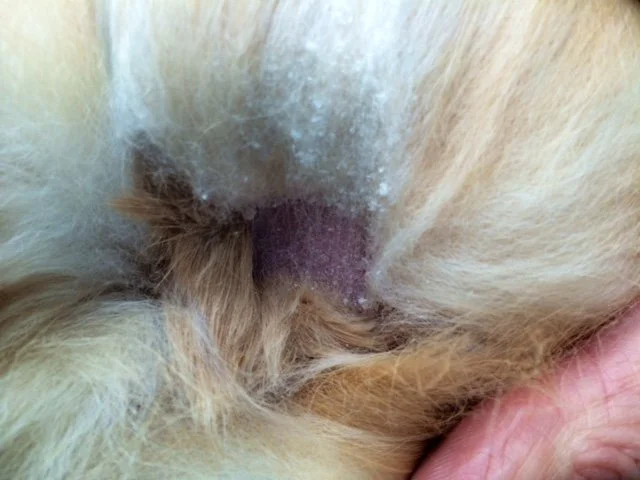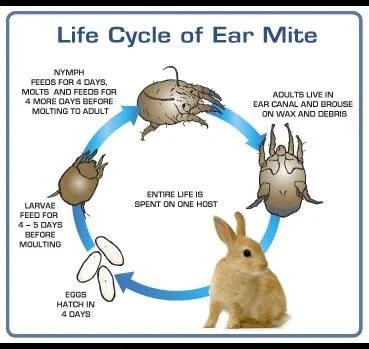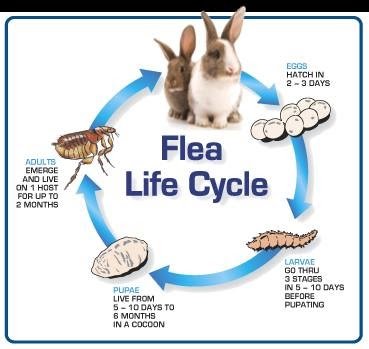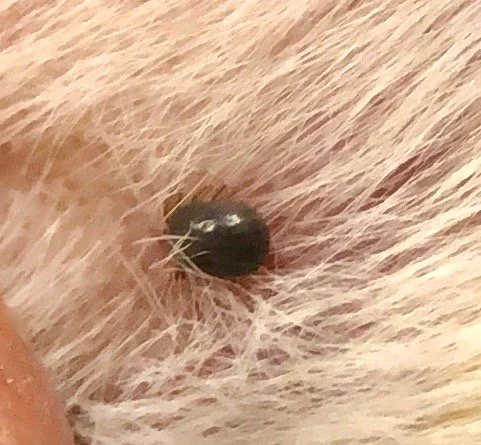Mites / Fleas / Lice / Ticks / Fur Loss / Skin Issues
NEVER USE FRONTLINE OR ANY PRODUCT CONTAINING FIPRONIL ON YOUR RABBIT
The skin ailments mentioned here are not all-inclusive. Home remedies are typically ineffectual and may lead to complications or even death.
It is always best to consult a rabbit savvy veterinarian rather than attempting home diagnosis and treatment.
Fur Loss / Alopecia
Fur loss in rabbits with no other lesions can have many different causes, including fur-plucking, barbering, hormonal problems, dental problems, fighting, urine scald, parasites (mites and fleas), skin and fungal infections and localised inflammation. Fur-plucking in the neck or dewlap, belly, and leg areas occurs in pregnant females who are close to delivery, to line their nest. Even pseudopregnant females sometimes pluck in that area. Fur-plucking may also be seen in cases of nutritional deficiency such as when they lack sufficient fibre in the diet. Rabbits who cannot reach the site of an irritation because of arthritis, obesity, or intervening skin folds sometimes chew at their dewlap instead. Simple baldness may result, but frequently the skin also appears irritated.
The fur at the nape of the neck is normally thin. Coat density in this area may change with the seasons or with hormonal fluctuations in un spayed females. It is normal if the bald spot is limited to the area hidden when the rabbit tucks her head back toward her shoulders. If the hair is thin beyond this spot, it is a good idea to have your veterinarian do an examination.
Occasionally hair loss can be seen at the site of a previous bite wound or other injury and is related to the healing process. Hair should regrow within a few months in these cases unless there was extensive scarring and deep damage to the skin.
Moulting - ‘Normal’ Hair Loss
Moulting-related naked patches of skin should not be confused with alopecia caused by skin parasites, diet-related nutrient or vitamin deficiencies (e.g., orange coloured points of hairs on a dark fur), sebaceous adenitis, cutaneous lymphoma, hormonal diseases or hair plucking in pseudopregnant females.
Rabbits go through periods of fur growth and renewal beginning at the head and ending with the tail, however, depending on the rabbit, it can also start in other body locations, e.g., the back region; with all shedding varying widely from one rabbit to another:
* Many rabbits shed 3 to 4 times a year with duration lasting several weeks; others shed constantly throughout the year seeming to be in a perpetual moult;
* Patterns of shedding may also vary: some shed in patches, in clumps of hair and even some exposing naked skin, others shed in waves, with marked lines between the old and new hair on the face or dorsum;
* Severity of shedding: progressive loss of old hair, or even suddenly in patches;
* Types of fur, short haired, fuzzy, angora.
The new hair is generally darker.
Source:
Varying shedding patterns among rabbits - MediRabbit
Shedding From The Ears - MediRabbit
CAUSES OF FUR LOSS, ITCHING, SCABS OTHER THAN MOULTING
Fur Mites
During normal shedding, the undercoat may come out in clumps, but no flaking should be seen. Patchy fur loss with mild to severe flaking along the rabbit’s back is the hallmark of Cheyletiella parasitovorax, the most common rabbit skin mite. Hairs at the border of the bald spot come out easily in clumps, usually with some coarse flakes of skin attached. Fur mites may or may not cause itching.
Your veterinarian may examine a scotch-tape preparation or skin scraping under the microscope for the presence of mites, but mites are sometimes difficult to detect. Luckily, mites are usually eradicated with relative ease.
It is essential to thoroughly clean your rabbit’s cage and exercise areas after each treatment to control reinfestation, since fur and dander in the environment may contain mite eggs.
Common Fur Mites or Cheyletiellosis - MediRabbit
Other types of Fur Mites including Red Mites
Less Common Fur Mites in Rabbits including Red Mites - MediRabbit
Mange
" Rabbits can be affected by mange, caused by burrowing mites ... Burrowing mites present a zoonotic danger; they can affect dogs, cats, and humans, causing a transient itching dermatitis. The burrowing mange Notoedres cati is occasionally observed to infest rabbits."
Mange - Burrowing Mites: Sarcoptes scapiei or Notoedres cati - MediRabbit
Ear mites
The rabbit ear mite, Psoroptes cuniculi, produces abundant red-brown crusts in the ear canal. The rabbit may shake his head or scratch at his ears or one or both ears may droop. This is a very uncomfortable disease. Mites may be seen with the naked eye, moving along the crusts. If they are not grossly visible they are easily detected via microscopic examination of the crusts and debris from the ear.
These mites can also be found on other areas of the skin, most commonly just above the tail, where they cause itching and crusts.
Below is what a severe case of ear mites looks like. This rabbit had been dumped and has now recovered in the care of Against All Odds Rabbit Rescue in Calgary. Photos used with permission from and credited to Amanda Greening.
It is not necessary to clean the ears and remove the crusts which is extremely painful. Once treated and the mites are killed, healing progresses rapidly and the crusts come out on their own. It is important as with the fur mites, the clean the rabbit’s environment after each treatment as a few mites may be present in the bedding from time to time.
Below you can see how much this bun's ear has improved only a few days after treatment was started.
Ear mite: Psoroptes cuniculi - MediRabbit
Fleas
The Rabbit flea - Spilopsyllus cuniculi, never made it to NZ when the European rabbit was introduced here. Opportunistic cat and dog fleas do hop on board our rabbits for a feed but they cannot breed on the rabbit.
Fleas can cause hair loss, redness, small crusts, and itching. Advantage, Evance or Revolution have been used successfully but it's important to use a mg/kg weight related dose.
Ridding the House of Fleas - The rabbit’s environment must also be treated. Regular, thorough vacuuming helps reduce the number of eggs in the environment. Environmental treatment with insect growth regulators (IGRs) and insecticide sprays; including flea bombs, are usually safe as long as the rabbits are removed until the product has dried, surfaces are wiped down, floors are washed and the carpets have been vacuumed.
You can read more about treating the house for fleas in these articles -
Fleas: Identification & Prevention
How to get rid of fleas - the 5 step process
How to use a flea bomb
Application of borax powder or diatomaceous earth to rugs and carpets is also safe and effective as long as your rabbit is kept off them until they are completely vacuumed up.
Products like the Pestrol Flea Trap can also be useful to help monitor how sucessful your eracication efforts have been.
Please note - the Medirabbit link includes treatments (Lufenuron/Program) that are not available in NZ and also suggests using Pyrethrin based products. Pyrethrins are toxic to rabbits (as stated elsewhere in Medirabbit) so we would advise using them near your rabbit only with extreme caution.
Fleas and Rabbits - MediRabbit
Lice
Clinical signs of a lice infestation may include intense scratching, bald patches within the fur, thinning of the fur and white eggs - nits, stuck to the hair shafts. With advanced infestations, the rabbit may appear very agitated, restless and may also lose weight and eat less because they spend so much time scratching. Anaemia may also be present, especially in very young rabbits, as lice feed by sucking the rabbit's blood. This is especially noticeable in albino rabbits which will appear very pale. Severe anaemia can cause weakness and even death.
The rabbit louse is Haemodipsus ventricosus, and is a sucking louse, but is thought to be rare in pet rabbits. They are normally found along the back and on the sides of the rabbit as well as around the rump area. Adult lice are visible with the naked eye and can be seen moving. The eggs (nits) are oval in shape and are laid and firmly attach to the shafts of the hair, these can also be seen with the naked eye. The entire lifecycle from egg to louse takes 2-5 weeks where environmental conditions are at an optimum.
Ticks
Ticks are usually found while inspecting the fur of a rabbit. Preferred locations are the ears, around the eyes and nose, the area between the ears, the neck and the dewlap of female rabbits.
Severe tick infestation can lead to anaemia and death.
Further Reading -
Ticks in rabbits - MediRabbit
Ringworm
Ringworm is not a worm but a fungus that takes its name from the classic raised red circular lesion with a clearing centre that can be a primary symptom. However, crusting, scaling, and bald spots are actually more common symptoms than the red ring. Ringworm most commonly occurs on the rabbit’s head, ears, and face
Further Reading -
Fungal Dermatitis or Superficial Mycosis - MediRabbit
Barbering
Barbering, or chewing on the hair, is sometimes seen when rabbits are housed together or with guinea pigs. Rabbits may chew on their own hair or on each other’s hair. The stress of crowding is likely to intensify the problem. Barbered areas show patchy hair loss with broken hairs present (they have been nipped off) without complete baldness.
Further Reading -
Rabbit Behavioral Problems: Barbering
Rabbit Syphilis
Treponema cuniculi is a bacteria called a spirochete similar to that which causes syphilis in humans. It causes crusty dermatitis primarily around the rabbit’s genitals or nose and mouth, but in severe cases is can extend upwards on the face and around the eyes.. It is not known how prevalent rabbit Syphilis is in NZ.
Further Reading -
Treponematosis - rabbit syphilis - MediRabbit
Chronic Wetness
If a rabbit’s skin is chronically exposed to moisture, then baldness, redness, and crusting may develop, and bacterial infection may follow. The source of the moisture may be the environment (water crocks, leaky water bottle, damp litter, overgrooming by another rabbit) or the rabbit’s own body fluids (urine leakage, fecal staining, drooling due to dental problems, or eye discharge). Infection by the bacterium Pseudomonas aeruginosa sometimes causes a moist dermatitis which shows as a blueish discoloration of the fur. If drinking water is contaminated with Pseudomonas, rigorous disinfection or replacement of water containers is essential.
Further Reading -
Chronic wetness of the chin or dewlap in rabbits: non-dental causes. - MediRabbit
Dental Problems
In some rabbits, fur loss is restricted to the area just under the chin, in the folds of the dewlap (the fleshy flap of skin and tissue under the skin), or down the chest. Often, but not always, the fur and/or skin there will be wet. In many, but not all cases, the rabbit will also develop suddenly picky eating habits. These can vary greatly among individuals, with some rabbits being willing to eat pellets, but not hay, others eating hay but not pellets, some refusing to drink, and still others refusing everything but the most favourite treats. In short, any change in eating preferences is usually a good enough reason for a dental exam by an experienced rabbit vet.
Dental problems such as molar spurs can make the bunny drool. Since saliva is caustic, it burns the skin, making the wet area itchy and sore, and causing the fur to fall out. Some rabbits will actually chew at the irritated area so much that they develop open sores.
More about Dental Issues in WW’s file - Dental Issues
Urine Scald
Like saliva, urine is caustic. If it collects in the fur, it will burn the underlying skin, causing fur to fall out and the skin to become red and raw.
More about Urine Scald in WW’s file - Urine & Rain Scald
Skin Swellings/Lumps/Melanoma
Abscesses
Abscesses are the most common skin swellings in rabbits. Because the pus produced by rabbits often has a thick cream cheese-like consistency and is encased in a thick capsule, lancing, draining, and systemic antibiotics often fail to effect a cure. Complete surgical removal of the intact abscess is preferred. There are a wide range of potential treatments for abscesses that are not able to be surgically removed for whatever reason. The most important thing is to get an anaerobic and an aerobic culture prior to any treatment to determine what the most appropriate antibiotic will be to give either systemically and/or into the abscess cavity itself. Treatments range from cleaning the abscess and implanting antibiotic impregnated beads to leaving it open and packing and/or flushing with a variety of medications. It is best to consult your veterinarian to determine what is the most appropriate regime of treatment for your individual rabbit.
More about Abscesses can be found here - Abscesses
The most common cause of lumps and bumps on rabbits are warts, caused by a papilloma virus and benign growths such as fatty tumours (lipomas). Malignant skin cancers are not common in the rabbit, but do occur and are most often a metastasis of another cancer, most notably uterine cancer. Any unusual growths on the skin should be watched for change in size, shape, or colour and should be evaluated by a veterinarian. If a skin mass is removed, it is a good idea to have your veterinarian send it out for pathology so it can be identified and any further treatment can be instituted if necessary.
Melanoma
Cutaneous Melanomas in Rabbits: Rare but Often Fatal - Mon, 17 Oct 2011 in Veterinary Science Development
Papillomas
Do horned rabbits really exist ? - Papillomatosis - MediRabbit
Further Reading -
Fur Loss and Skin Problems in Rabbits: Common Causes and Treatments - Dana Krempels
TREATMENT OPTIONS
Fleas:
Apply topical treatments to the skin on the back of the neck or other area where the rabbit can’t readily groom it off.
* Advantage or Evance = Imidacloprid 100mg/ml. Topical application for fleas and lice. Safe to use from 10 weeks old.
Treatment and prevention of fleas on rabbits. One application lasts for 1 week on rabbits. It also kills larval flea stages in the environment. It is recommended that all rabbits and other animals in the same environment should be treated. Imidacloprid may be used as the only product for flea control as it breaks the life cycle and kills all adult fleas emerging from the environment before they successfully re-infest the rabbit.
Dosage:
Rabbits up to 4kg = 0.4ml or 1 pipette of Advantage/Evance for cats and rabbits up to 4kg.
Rabbits over 4kg = 0.8ml or 1 pipette of Advantage/Evance for cats and rabbits 0ver 4kg.
* Revolution - DO NOT use Revolution Plus. It is important to use a weight related dose. This is discussed below.
Can be used 8 weeks of age and over.
Dosage: See charts below.
May only be effective for 1 week if treating fleas.
Westley's World sell a Flea and Mite Kit which includes a dosage chart and contains triple strength (Dog vs Cat) Revolution. This makes it a more affordable treatment option.
Ridding the House of Fleas - The rabbit’s environment must also be treated. Regular, thorough vacuuming helps reduce the number of eggs in the environment. Environmental treatment with insect growth regulators (IGRs) and insecticide sprays; including flea bombs, are usually safe as long as the rabbits are removed until the product has dried, surfaces are wiped down, floors are washed and the carpets have been vacuumed. You can read more about treating the house for fleas here - Fleas: Identification & Prevention. Application of borax powder or diatomaceous earth to rugs and carpets is also safe and effective as long as your rabbit is kept off them until they are completely vacuumed up.
Please note - the link below includes treatments (Lufenuron/Program) that are not available in NZ and also suggests using Pyrethrin based products. Pyrethrins are toxic to rabbits (as stated elsewhere in Medirabbit) so we would advise using them near your rabbit with extreme caution.
Fleas and Rabbits - MediRabbit
Mites - Ear and Fur:
Apply topical treatments to the skin on the back of the neck or other area where the rabbit can’t readily groom it off.
* Revolution - DO NOT use Revolution Plus. It is important to use a weight related dose. This is discussed below.
Can be used 8 weeks of age and over.
Dosage: See chart below.
Application last for 1-2, possibly up to 4 weeks on rabbits when treating fur mites.
Give one dose, a second may be necessary 10-14 days later. If this does not clear the infection then Ivomec injections by your vet would be the next step.
Westley's World sell a Flea and Mite Kit which includes a dosage chart and contains triple strength (Dog vs Cat) Revolution. This makes it a more affordable treatment option.
* Advocate - Imidocloprid (same as Advantage and Evance) + Moxidectin (a mitecide)
Sometimes used off label to treat mites in rabbits.
The effective dose rate in a study dealing with topical use of Moxidectin was found to be 1mg/kg or 0.1ml/kg of cat Advocate.
Dosage:
A pipette for cats up to 4kg which contains 0.4mls will treat a rabbit up to 4 kgs in weight.
A pipette for cats 4-8kg which contains 0.8mls will treat a rabbit from 4-8kgs in weight.
In regard to Advocate’s worming properties - although Advocate can treat mites in rabbits it will not effectively deliver a strong enough dose of Moxidectin to treat intestinal worms in rabbits because even applied at very high dose rates (the dose rate used in the study was twice the dose rate that is used for cattle) uptake of moxidectin in rabbits appeared to differ from other animal species, indicating a lower systemic bioavailability of moxidectin in rabbits following topical administration.The study states "The low systemic exposure of moxidectin in rabbits is probably attributable to the retention of the drug in the skin which limits the absorption process"
* Bravecto - this will kill ear mites. However it must be kept in mind that its use would be off label for a rabbit.
Dosage: Fluralaner at 25 mg/kg
An article in Veterinary Dermatology, March 2017 discussed the use of Fluralaner/Bravecto for the treatment of ear mites in rabbits -
Use of oral fluralaner for the treatment of Psoroptes cuniculi in 15 naturally infested rabbits - Galia Sheinberg*, Camilo Romero†, Rafael Heredia†, Miguel Capulin†, Enrique Yarto* and Juan Carpio‡
This study concluded - "oral fluralaner at a 25 mg/kg dose was effective in the treatment of naturally occurring P. cuniculi in 15 rabbits, without the need for any additional topical or systemic medications."
Because Fluralaner was well tolerated by the rabbits and was also effective in the treatment of ear mites, the use of Bravecto may be an option worth considering in severely resistant mite infestations in rabbits.
Lice:
* Ivomec injections at 0.4 mg/kg, SC at 7-10 days apart for 3-4 treatments are normally effective. Treatment needs to last long enough to eradicate the eggs as they hatch.
Apply topical treatments to the skin on the back of the neck or other area where the rabbit can’t readily groom it off.
* Advantage or Evance (Imidacloprid 100mg/ml) is effective in dogs and could also be used in rabbits over 10 weeks of age. One application lasts for 1 week on rabbits.
Dosage:
Rabbits up to 4kg = 0.4ml or 1 pipette of Advantage/Evance for cats and rabbits up to 4kg.
Rabbits over 4kg = 0.8ml or 1 pipette of Advantage/Evance for cats and rabbits 0ver 4kg.
* Revolution - DO NOT use Revolution Plus. It is important to use a weight related dose. This is discussed below. Can be used 8 weeks of age and over.
Dosage:
Most effective dose is 18mg/kg
This equates to 0.3mls per kilo of rabbit weight of Cat Revolution (60mg/ml concentration)
Give one dose, a second may be necessary 10-14 days later. If this does not clear the infection then Ivomec injections by your vet would be the next step.
Westley's World sell a Flea and Mite Kit which includes a dosage chart and contains triple strength (Dog vs Cat) Revolution. This makes it a more affordable treatment option.
Lice are species specific, but it is wise to get your rabbit treated as soon as you notice any symptoms, and to clean the environment after every treatment.
Ticks:
Physical Removal - As many ticks as possible should be carefully removed with forceps or a Tick Lasso, and killed rapidly by immersion in an acaricide solution, alcohol, or chloroform solution. This avoids eventual contamination or spreading diseases carried by the tick host.
A Tick Lasso is a safe and easy way to remove Ticks. You'll need to Google to find a supplier.
* Ivomec - There is no approved treatment for Ticks in rabbits but if the presence of further ticks is noticed, or if the infestation is severe, administration of Ivomec by your vet will make the ticks drop off BUT it won't kill them.
Dosage: 0.4 mg/kg, SC, once.
* Bravecto - this kills ticks. However it must be kept in mind that its use would be off label for a rabbit.
Dosage:
Oral Fluralaner at a 25 mg/kg
An article in Veterinary Dermatology, March 2017 discussed the use of Fluralaner/Bravecto for the treatment of ear mites in rabbits -
Use of oral fluralaner for the treatment of Psoroptes cuniculi in 15 naturally infested rabbits - Galia Sheinberg*, Camilo Romero†, Rafael Heredia†, Miguel Capulin†, Enrique Yarto* and Juan Carpio‡
This study concluded - "oral fluralaner at a 25 mg/kg dose was effective in the treatment of naturally occurring P. cuniculi in 15 rabbits, without the need for any additional topical or systemic medications."
Because Fluralaner was well tolerated by the rabbits and was also effective in the treatment of ear mites, the use of Bravecto may be an option worth considering to treat a severe Tick infestation in rabbits.
It is worth noting that plain Revolution is only effective against the American Dog Tick (as stated by Zoetis on their product insert/pamphlet), which we don’t have here in NZ. Revolution Plus has Sarolaner added to it and this chemical treats the Asian longhorned tick/ Cattle Tick (Haemaphysalis longicornisother) that we have in NZ. BUT it is not tested for or rated as safe to use on rabbits.
WARNING***Although they successfully kill ticks, the use of insecticide products containing pyrethrin & permethrin must be avoided, due to their secondary toxic effects in rabbits. Fipronil is forbidden for use in rabbits***
Ringworm
Your veterinarian may provide topical treatment (miconazole, clotrimazol) for small lesions or oral medication for larger areas.
Barbering
Here are some ideas to try to address potential stress based causes of Barbering:
*Look at ways to increase enrichment such as using treat balls to dispense their pellets, using toilet roll stuffed with green/hay with a few pellets in the middle etc. Check out the Enrichment section for more ideas.
*Play some calming music as background noise for them to reduce any environmental and sudden noises which may be causing stress.
Westley's World also suggests the following -
*Use Catnip spray (the one sold for cats) and or Lavender oil in their area. These are both safe for rabbits and have a calming effect on them.
*Look into feeding plants such as Cleavers, Calendula flowers - both healing plants. Chamomile, Mayweed & Lemon balm are calming, and Hawkweeds and Puha for their vitamins and minerals and tonic properties.
Rabbit Syphilis
This organism is resistant to most topical treatments but responds well to procaine penicillin G injections. One must take care and watch for intestinal upset during this treatment.
Chronic Wetness
Finding out where the moisture is coming from and eliminating the source is the first and most important step toward a cure. Steps may include veterinary treatment for problems like arthritis, bladder problems , conjunctivitis, a change in diet to correct obesity. Rabbits with these problems should not be allowed outdoors because they are at risk for fly strike.
Daily care of the affected area is necessary and may include clipping, cleansing with chlorhexidine or tamed iodine solution, and applying topical antibiotic/anti-inflammatory powder or ointment. Intensive or prolonged use of topical corticosteroids can have systemic effects and should be avoided. Systemic antibiotics (based on culture/sensitivity testing) are needed if there is pus, fever, or lethargy.
A DISCUSSION ON THE DOSE RATES FOR THE USE OF REVOLUTION IN RABBITS.
Dose Rates - An older and now outdated dosing approach is to use the same as that for cats as follows:
1 x kitten pipette (0.25mls) for rabbits up to 2.5kg
1 x cat pipette (0.75mls) for rabbits 2.6kg and over.
Westley’s World has researched the latest studies and this approach has been found to deliver an inadequate dose of Revolution and many rabbit savvy vets will now dose (by weight) at either 12mg/kg, 15mg/kg or 18mg/kg of Revolution. Westley’s World has discussed this with rabbit specialist vets and who confirm that the higher 18mg/kg dose rate is the most effective for rabbits.
Another recent study has shown that to treat fleas effectively an even higher dose rate of 20mg/kg may be needed and that it may only persist in the rabbit’s body at effective levels for 1 week.
The chart below gives the dose rates for using both cat strength (60 mg/ml) and dog strength (120 mg/ml) Revolution for your rabbit.
Reading the chart -
Red Arrow = establish the concentration of your pipette. This example is for Dog Revolution / 120mg/ml
Top/Vertical Green Arrow = find your rabbit’s weight. The rabbit in this example is 2.04 kgs (Left hand/Horizontal Green Arrow)
Blue Box = The number where the Red and Green Arrows intersect is the dose of Revolution to apply to your rabbit.
Using Cat Revolution - 60mg/kg
*At 18mg/kg the dose rate of Cat - 60mg/ml strength, would be 0.3mls per kilo.
One kitten/puppy pipette holds 0.25mls and will treat an 825gm rabbit.
One cat pipette holds 0.75mls and will treat up to a 2.5kg rabbit.
*At 20mg/kg the dose rate of Cat - 60mg/ml strength, would be 0.33mls per kilo.
One kitten/puppy pipette holds 0.25mls and will treat a 750gm rabbit.
One cat pipette holds 0.75mls and will treat up to a 2.25kg rabbit.
The source of the chart and info above and a calculator to help you work out the correct dose for your rabbit if needed can be found here -
Rabbit Revolution, Paradyne, Stronghold, Selehold, & Clearkill SMT [Selamectin] Information Rabbits
Westley's World sell a Flea and Mite Kit which includes a dosage chart and contains double strength (Dog) Revolution. This makes it a very affordable treatment option.
Alternative treatments -
DME/Smite
Westley's World does not encourage or condone the use of DME on or around rabbits as it is a potent lung irritant if inhaled. In addition it has the potential to cause GI tract irritation and damage if ingested.
Tea Tree Oil
This is not safe to use on or near your rabbit in any form.











